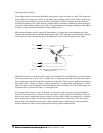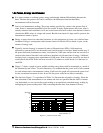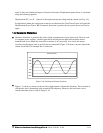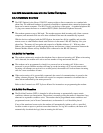
Q
Inductive and capacitive impedance are present in all power systems. We are accustomed to thinking
about these impedances as they perform at 60 Hz. However, these impedances are subject to
frequency variation.
X
L
= jωL and
X
C
= 1/jωC
At 60 Hz, ω = 377; but at 300 Hz (5
th
harmonic) ω = 1,885. As frequency changes impedance
changes and system impedance characteristics that are normal at 60 Hz may behave entirely
different in presence of higher order harmonic waveforms.
Traditionally, the most common harmonics have been the low order, odd frequencies, such as the
3
rd
, 5
th
, 7
th
, and 9
th
. However newer, new-linear loads are introducing significant quantities of
higher order harmonics.
Q
Since much voltage monitoring and almost all current monitoring is performed using instrument
transformers, the higher order harmonics are often not visible. Instrument transformers are designed
to pass 60 Hz quantities with high accuracy. These devices, when designed for accuracy at low
frequency, do not pass high frequencies with high accuracy; at frequencies above about 1200 Hz
they pass almost no information. So when instrument transformers are used, they effectively filter
out higher frequency harmonic distortion making it impossible to see.
Q
However, when monitors can be connected directly to the measured circuit (such as direct
connection to 480 volt bus) the user may often see higher order harmonic distortion. An important
rule in any harmonics study is to evaluate the type of equipment and connections before drawing a
conclusion. Not being able to see harmonic distortion is not the same as not having harmonic
distortion.
Q
It is common in advanced meters to perform a function commonly referred to as waveform capture.
Waveform capture is the ability of a meter to capture a present picture of the voltage or current
waveform for viewing and harmonic analysis. Typically a waveform capture will be one or two
cycles in duration and can be viewed as the actual waveform, as a spectral view of the harmonic
content, or a tabular view showing the magnitude and phase shift of each harmonic value. Data
collected with waveform capture is typically not saved to memory. Waveform capture is a real-time
data collection event.
Waveform capture should not be confused with waveform recording that is used to record multiple
cycles of all voltage and current waveforms in response to a transient condition.
Electro Industries/GaugeTech
Doc # E107706 V1.25 1-12


















